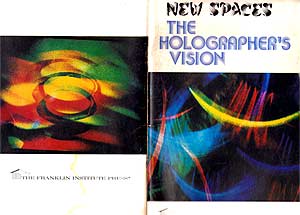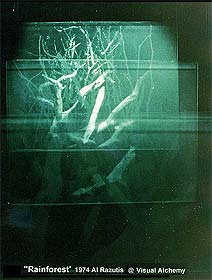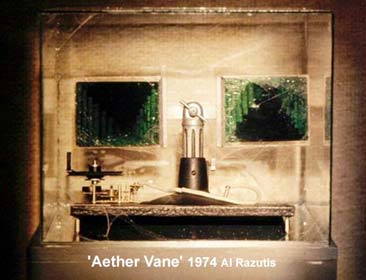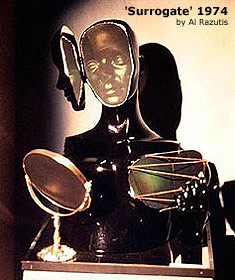
New Spaces: The Holographer's Vision, Franklin Institute Press, 1979

AL RAZUTIS
From Mimesis to Surrealism
Mimesis, the imitation of reality, is a well-known beginning, and the first stage of accomplishment, for the holographic artist. Having contended with hours of toil and experimentation, many will see their first results, the mimetic image, as an end in itself. A simple example of mimetic holography can be seen in holograms that render a virtual image of a toy train, King Tut's mask, geometric solids, jewelry or curios. To the artist truly interested in exploring the aesthetics of the medium, these exercises are merely akin to sharpening the pencil and acquiring basic craft-like skills. Mimetic holography, left to itself, merely restates what a 20th century public already knows, namely, dimension, perspective, proportion, proximity, size, and form. Of course, an undiscerning public may be initially fascinated by this contemporary "magic," but this fascination will soon evaporate and leave the artist's sense of accomplishment quite vacant. The mimetic mandate will demand a larger, brighter, better resolved, full color, motion picture rendition, with quadraphonic sound added—all at the expense of more sophisticated conceptual and perceptual investiga tion. Compounding this will be the cultural demand for spectacle (motion picture holographic billboards on Sunset Strip!) and maximal experience through novelty. As an artist, and one not particularly prone to mimetic expression, I am dismayed. The largest transmission holograms that I created (24" x 30", with a depth of field of 6 feet) are no more satisfying, except in terms of the above cultural prerequisite, than those measuring 4" x 5". In most cases, the aesthetic concepts and experience are the same. After all, what is the aesthetic of scale and size, unless it is somehow intrinsically related to the architecture of the surrounding space? But the disenchantment with reproducing reality can best be illustrated with the following two considerations. First, is not the reproduction of reality inherently redundant? Why not simply install a large sheet of glass, place objects behind it, and illuminate both with laser? After all, imitative considerations only treat the transparency of the holographic image as a temporary flaw! Secondly, if spectacle is what we're after, Disneyland has outdone everyone. For in their Haunted House ballroom display, they feature non-holographic renditions of ghosts flying about the setting. This technique of using mechanized mannequins, reflected in a partially transparent angled mirror, allows the viewer to engage in experience of illusory spectacle (60 feet of it) and is optically analogous to the holographic virtual image experience.
Mimetic holography reaches a curious apex in what I will loosely term pure holography. Rather than presenting a framed plate, con spicuously present as a formal gesture of rendering, the holographic plate or film is rendered almost invisible—for example, suspended in a room, with little or no ambient light—and the image is rendered in space behind or in front of the plate in orthoscopic configuration. The creation of image-objects floating in space, with whatever contained field of view, and free from contextual confines, is, to say the least, unnatural. In that it does not readily conform with our everyday experiences, it is extraordinary. (On a technical note, this process also can be accomplished by projecting a pseudoscopic image into a spherical mirror and reconstructing the final result as orthoscopic image in space.) Hence, the pursuit of realism in holography reaches its apex of expression in the creation of surrealism.
The nature of surrealism is to create a sense of anomaly either by the use of optical paradox or thematic ambiguity and paradox. The pseudoscopic image in holography is one such paradox. Though mimetic in nature (the laws of light are the laws of nature—it is only our habituated sense of reality that would have difficulty in accepting this), it presents a paradoxical experience of space to the viewer accustomed to normal orthoscopic perspective.
Perceiving New Spaces:
The Didactic Nature of Hybrid Holography
One of the basic struggles of an emerging medium is to convince the public of its importance. Aside from the familiar technique of engaging in hyperbolic argument, the act of educating the viewer is carried out in two ways: by a declaration of perceptual/conceptual principles and by an accompanying reeducation of the viewer's ability to perceive space. Considering the omnipresence of two-dimensional graphic media (painting, photography, and their kinetic successors, film and television), the task of reeducation would seem to be all the more difficult.
Holography, as is true in all visual media, presents a system of signs, codes—a language—that, in effect, must be read. To engage in the reading of these visual texts is a necessary prerequisite to understand ing holography's aesthetic propositions. The artist enters into this kind of discourse by the creation and exhibition of the artifact; the viewer's participation in the discourse is determined by his/her interest in, and familiarity with, the subject matter. In the case of the mimetic technical hologram, the visual text is usually quite simple, and its presentation usually evokes questions relating to process of creation or presentation: "How was it done?" In this case, the public is usually referred to explanatory material. This circumstance is basically didactic in nature and not directly related to aesthetic investigation. An aesthetic based on "how was it done?" or "what materials were used?" would be the same as equating instructional processes with beauty—a ludicrous, but not uncommon, proposition.
A more fruitful area of investigation occurs when we consider two hybrid forms of holography: the graphic-hybrid hologram and the sculptural-hybrid hologram. The first category is representative of works that are usually presented in the familiar graphic format (i.e., framed, and hung on a wall), and feature a play on the flatness of graphic image(s) and context of presentation, as contrasted by the depth and dimensionality of the holographic image. Here we have two aesthetic attitudes presented as a visual discourse, with a resultant synthesis as aesthetic gesture. Rainbow holograms are an evident example of this, though their lack of vertical parallax weakens their ability to articulate the relationship between image and flat plane. In reflection holography, the plane of glass, under normal installation circumstances, will always be evident and part of the composition. It is in this regard that I am reminded of some of the work of Anait Stephens who, taking this consideration in mind, articulates the relationship between implied perspective (of a graphic wedge collaged to the glass) and the spatial characteristics of the holographic image. In my work, I have been prone to articulate this relationship by the use of a mirror- plane ("Prima Materia," or "Point Source"), which acts as conceptual plane reference (the mirror, in effect, is physically there, but it bisects not only the holographic plane of imagery but also the viewer's physical plane). A further extension of the graphic-hybrid is found in work that features serial holograms. Whether image-serialization uses juxtaposition of orthoscopic and pseudoscopic images, as in the works of Anait or my "Newtonian Galactic Assembly Line," or complex patterns of mosaic composition, the results are initially derivative of graphic-serialization (Warhol) processes. However, the spatial texture that these works exhibit (a texture that must be experienced by a viewer moving about and seeing the compositional dynamics from multiple vantage points) can only be rendered in the domain of holography. Further examples of graphic-hybrids include work that features surface texture, shadow-etchings of the holographic image (as in my "Rainforest"), multiple-plate (in-depth) installations, and the inclusion of mathematical formulae (as in "Point Source") of written information (as in "Newtonian Anagraph"). The final result of this type of hybrid expression is two-fold: first, it establishes an aesthetic transition from graphic to holographic; secondly, it reveals the obsolescence of Renaissance-graphic rules of perspective and articulates the basic nature of the holographic departure.
The second category, that of the sculptural-hybrid, is intrinsically more complex. Works of this nature feature a combination of sculptural (spatial) artifact and holographic image—each of which contributes to a resultant synthesis. The Multiplex stereogram can be considered in this light, but once again it fails to articulate clearly the synthetic relationship between its evident shape (the cylinder) and the holographic image contained within. (The magic of the artifact in the bottle will not suffice as aesthetic gesture). I have only seen a few Multiplex stereograms that have even approached a successful synthesis, and one ("Three Objects in Space" by Anait) is largely successful because it makes explicit use of the limitations of this process (namely, spectral rendering in place of vertical parallax). In other words, it is specific to the material and process of expression, and clearly articulates this relationship. (Not to work within the nature of the material and process would be akin to a sculptor in marble attempting to articulate the qualities of mass-cast resin!) Examples of other work in this category include my reflection holograms, "Surrogate" and "Aether Vane", and 180-degree transmission pieces, such as "Inclined/Stressed/Plane" and "Chain Link". The subject matter for this synthesis can be extended beyond mere consideration of materials and form. In "Surrogate, the mythical connection between images (the holographic face in the vanity mirror) approaches the classical concern for vanity and death (Vanitas); in "Aether Vane" the visual context of cobwebs (obsolescence) and an antiquated device for measuring, as it were, the nonexistent aether alludes to both the preoccupations of the scientific community (Michelson-Morley) and the dimensional (hence material) properties of light. It is didactic in nature, but humorous in intent. The sculptural-hybrid, moreso than the graphic-hybrid, is fundamental to holography because both aspects of the hybrid—the sculptural and holographic—are naturally related, and to divorce them completely would amount to a cessation of aesthetic dialogue between matter and light.
Holographic Expressionism
Works that are expressionist in nature prominently feature the artist's intercession or gesture. This aspect of holography is in direct opposition to the precepts of mimesis. The primary focus of expres sionism is the synthesis of experience and language via the personal touch of the artist's imagination. Rather than reproduce a given reality, the artist engages in a romantic quest to discover or create other realities. Examples of this kind include the use of painterly-like "brush strokes" (painting on emulsion) found in the works of Anait, patterns of ripples in sand (object expressionism) found in the work of Dunkley, or even the use of interferometric techniques to create controlled contour lines in space (a "stress topography" in which a black ribbon-like waterfall effect is created) as in my "Perspective Wedge (Stress Topography) # 1,2,3". Ultimately, such expressionistic investigations can lead an artist to the central concerns of conceptual and environmental art.
Al Razutis, 1979
Works by Al Razutis appearing in the exhibition / catalog (link to enlarge):



Index of Writings - Essays - Manifestos